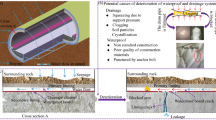Abstract
In double-lined tunnels, geotextiles are installed between shotcrete and concrete linings to drain ground water that is in the circumferential boundary of the tunnels. During the concrete lining placement, the geotextile often experiences pressures from young concrete on the curved and rough shotcrete surfaces. The pressures are transferred through a waterproof membrane, and act in the normal direction to the curved shotcrete face. The geotextile flow behavior under these conditions cannot be represented by standard geotextile permeability tests. Instead, it requires specially designed performance tests that consider field conditions. A new device to evaluate the permeability of the geotextile in pressurized curved flow channels is proposed; it adopts a flexible loading system and a curved and rough model plate. Testing of geotextiles used for tunnel drainage systems, using the proposed arrangement, shows that the effects of the tortuousity of the flow in pressurized channels affects significantly the geotextile permeability.
Similar content being viewed by others
References
ASTM D4716-08 (2013). Standard test method for determining the (Inplane) flow rate per unit width and hydraulic transmissivity of a geosynthetic using a constant head, Annual Book of ASTM Standards, ASTM International, West Conshohocken, PA.
Barton N. and Choubey V. (1977). “The shear strength of rock joints in theory and practice.” Rock Mechanics, Vol. 10, pp. 1–54.
Hoek, E. and Bray, J. W. (1996). Rock slope engineering, Revised Third Edition, E & FN SPON, London, pp. 131–134.
Louis, C. (1976). Introduction à l’hydraulique des roches, PhD Thesis, D’etat Es-sciences Physiques de l’Universite Pierre et Marie Curie, Paris.
Palmeira, E. M. and Gardoni, M. G. (2002). “Drainage and filtration properties of non-woven geotextiles under confinement using different experimental techniques.” Geotextiles and Geomembranes, Vol. 20, pp. 97–115.
Shin, J. H. (2008). “Numerical modeling of coupled structural and hydraulic interactions in tunnel linings.” Structure Engineering and Mechanics, Vol. 29, pp. 1–16.
Shin, J. H., Addenbrooke, T. I., and Potts, D. M. (2002). “A numerical study of the effect of groundwater movement on long-term tunnel behavior.” Geotechnique, Vol. 52, pp. 391–403
Shin, J. H., Potts, D. M., and Zdravkovic L. (2005). “The effect of porewater pressure on NATM tunnel linings in decomposed granite soil.” Canadian Geotechnical Journal, Vol. 42, pp. 1585–1955.
Author information
Authors and Affiliations
Corresponding author
Rights and permissions
About this article
Cite this article
Murillo, C.A., Shin, J.H., Kim, K.H. et al. Performance tests of geotextile permeability for tunnel drainage systems. KSCE J Civ Eng 18, 827–830 (2014). https://doi.org/10.1007/s12205-014-0753-2
Received:
Accepted:
Published:
Issue Date:
DOI: https://doi.org/10.1007/s12205-014-0753-2




